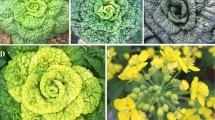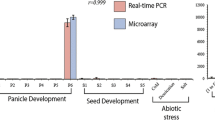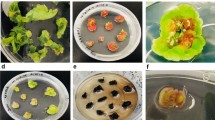Abstract
Prevention of transgene flow from genetically modified crops to food crops and wild relatives is of concern in agricultural biotechnology. We used genes derived from food crops to produce complete male sterility as a strategy for gene confinement as well as to reduce the food purity concerns of consumers. Anther-specific promoters (A3, A6, A9, MS2, and MS5) were isolated from Brassica oleracea and B. rapa and fused to the β-glucuronidase (GUS) reporter gene and candidate genes for male sterility, including the cysteine proteases BoCysP1 and BoCP3, and negative regulatory components of phytohormonal responses involved in male development. These constructs were then introduced into Arabidopsis thaliana. GUS analyses revealed that A3, A6, and A9 had tapetum-specific promoter activity from the anther meiocyte stage. Male sterility was confirmed in tested constructs with protease or gibberellin insensitive (gai) genes. In particular, constructs with BoCysP1 driven by the A3 or A9 promoter most efficiently produced plants with complete male sterility. The tapetum and middle layer cells of anthers expressing BoCysP1 were swollen and excessively vacuolated when observed in transverse section. This suggests that the ectopic expression of cysteine protease in the meiocyte stage may inhibit programmed cell death. The gai gene also induced male sterility, although at a low frequency. This is the first report to show that plant cysteine proteases and gai from food crops are available as a novel tool for the development of genetically engineered male-sterile plants.





Similar content being viewed by others
Abbreviations
- CaMV:
-
Cauliflower mosaic virus
- CKX:
-
Cytokinin oxidase/dehydrogenase
- GA:
-
Gibberellin
- GM:
-
Genetically modified
- GUS:
-
β-Glucuronidase
- ORF:
-
Open reading frame
- PCR:
-
Polymerase chain reaction
- RACE:
-
Rapid amplification of cDNA ends
- PCD:
-
Programmed cell death
- TAIL-PCR:
-
Thermal asymmetric interlaced PCR
References
Aarts MG, Dirkse WG, Stiekema WJ, Pereira A (1993) Transposon tagging of a male sterility gene in Arabidopsis. Nature 363:715–717
Aarts MG, Hodge R, Kalantidis K, Florack D, Wilson ZA, Mulligan BJ, Stiekema WJ, Scott R, Pereira A (1997) The Arabidopsis MALE STERILITY 2 protein shares similarity with reductases in elongation/condensation complexes. Plant J 12:615–623
Alexander MP (1969) Differential staining of aborted and nonaborted pollen. Stain Technol 44:117–122
An G, Ebert PR, Mitra A, Ha SB (1988) Binary vectors. In: Gelvin SB, Schilpeoort RA (eds) Plant molecular biology manual. Kluwer, Dordrecht, pp 1–19
Beers EP, Woffenden BJ, Zhao C (2000) Plant proteolytic enzymes: possible roles during programmed cell death. Plant Mol Biol 44:399–415
Cheng H, Qin LJ, Lee SC, Fu XD, Richards DE (2004) Gibberellin regulates Arabidopsis floral development via suppression of DELLA protein function. Development 131:1055–1064
Clough SJ, Bent AF (1998) Floral dip: a simplified method for Agrobacterium-mediated transformation of Arabidopsis thaliana. Plant J 16:735–743
Coupe SA, Sinclair BK, Watson LM, Heyes JA, Eason JR (2003) Identification of dehydration-responsive cysteine proteases during post-harvest senescence of broccoli florets. J Exp Bot 54:1045–1056
Daniell H (2002) Molecular strategies for gene containment in transgenic crops. Nat Biotechnol 20:581–586
Eason JR, Ryan DJ, Watson LM, Hedderley D, Christey MC, Braun RH, Coupe SA (2005) Suppression of the cysteine protease, aleurain, delays floret senescence in Brassica oleracea. Plant Mol Biol 57:645–657
Glover J, Grelon M, Craig S, Chaudhury A, Dennis E (1998) Cloning and characterization of MS5 from Arabidopsis: a gene critical in male meiosis. Plant J 15:345–356
Hatakeyama K, Ishiguro S, Okada K, Takasaki T, Hinata K (2003) Antisense inhibition of a nuclear gene, BrDAD1, in Brassica causes male sterility that is restorable with jasmonic acid treatment. Mol Breed 11:325–336
Hayashi Y, Yamada K, Shimada T, Matsushima R, Nishizawa NK, Nishimura M, Hara-Nishimura I (2001) A proteinase-storing body that prepares for cell death or stresses in the epidermal cells of Arabidopsis. Plant Cell Physiol 42:894–899
Hedden P, Phillips AL, Coles J, Thomas S, Appleford N, Ward D, Beale M, Lenton J (1999) Gibberellin biosynthesis: genes, regulation and genetic manipulation. RIKEN Rev 21:29–30
Heeb S, Itoh Y, Nishijyo T, Schnider U, Keel C, Wade J, Walsh U, O’Gara F, Haas D (2000) Small, stable shuttle vectors based on the minimal pVS1 replicon for use in gram-negative, plant-associated bacteria. Mol Plant Microbe Interact 13:232–237
Higo K, Ugawa Y, Iwamoto M, Korenaga T (1999) Plant cis-acting regulatory DNA elements (PLACE) database: 1999. Nucleic Acids Res 27:297–300
Hird DL, Worrall D, Hodge R, Smartt S, Paul W, Scott R (1993) The anther-specific protein encoded by the Brassica napus and Arabidopsis thaliana A6 gene displays similarity to β-1, 3-glucanases. Plant J 4:1023–1033
Huang S, Cerny RE, Qi YL, Bhat D, Aydt CM (2003) Transgenic studies on the involvement of cytokinin and gibberellin in male development. Plant Physiol 131:1270–1282
Jefferson RA (1987) Assaying chimeric genes in plants: the GUS gene fusion system. Plant Mol Biol Rep 5:387–405
Jung KH, Han MJ, Lee YS, Kim YW, Hwang I, Kim MJ, Kim YK, Nahm BH, An G (2005) Rice Undeveloped Tapetum1 is a major regulator of early tapetum development. Plant Cell 17:2705–2722
Kawanabe T, Ariizumi T, Kawai-Yamada M, Uchimiya H, Toriyama K (2006) Abolition of the tapetum suicide program ruins microsporogenesis. Plant Cell Physiol 47:784–787
Kiba T, Aoki K, Sakakibara H, Mizuno T (2004) Arabidopsis response regulator, ARR22, ectopic expression of which results in phenotypes similar to the wol cytokinin-receptor mutant. Plant Cell Physiol 45:1063–1077
Koizumi M, Yamaguchi-Shinozaki K, Tsuji H, Shinozaki K (1993) Structure and expression of two genes that encode distinct drought-inducible cysteine proteinases in Arabidopsis thaliana. Gene 129:175–182
Koltunow AM, Truettner J, Cox KH, Wallroth M, Goldberg RB (1990) Different temporal and spatial gene expression patterns occur during anther development. Plant Cell 2:1201–1224
Koncz C, Schell J (1986) The promoter of the TL-DNA gene 5 controls the tissue-specific expression of chimaeric genes carried by a novel type of Agrobacterium binary vector. Mol Gen Genet 204:383–396
Lee S, Jung KH, An G, Chung YY (2004) Isolation and characterization of a rice cysteine protease gene, OsCP1, using T-DNA gene-trap system. Plant Mol Biol 54:755–765
Lee YH, Chung KH, Kim HU, Jin YM, Kim HI, Park BS (2003) Induction of male sterile cabbage using a tapetum-specific promoter from Brassica campestris L. ssp. pekinensis. Plant Cell Rep 22:268–273
Li N, Zhang DS, Liu HS, Yin CS, Li XX, Liang WQ, Yuan Z, Xu B, Chu HW, Wang J, Wen TQ, Huang H, Luo D, Ma H, Zhang DB (2006) The rice tapetum degeneration retardation gene is required for tapetum degradation and anther development. Plant Cell 18:2999–3014
Li Y, Cheng ZM, Smith WA, Ellis DR, Chen YQ, Zheng XL, Pei Y, Luo KM, Zhao DG, Yao QH, Duan H, Li Q (2004) Invasive ornamental plants: Problems, challenges, and molecular tools to neutralize their invasiveness. CRC Crit Rev Plant Sci 23:381–389
Liu YG, Mitsukawa N, Oosumi T, Whittier RF (1995) Efficient isolation and mapping of Arabidopsis thaliana T-DNA insert junctions by thermal asymmetric interlaced PCR. Plant J 8:457–463
Mariani C, Debeuckeleer M, Truettner J, Leemans J, Goldberg RB (1990) Induction of male sterility in plants by a chimeric ribonuclease gene. Nature 347:737–741
Matsuda N, Tsuchiya T, Kishitani S, Tanaka Y, Toriyama K (1996) Partial male sterility in transgenic tobacco carrying antisense and sense PAL cDNA under the control of a tapetum-specific promoter. Plant Cell Physiol 37:215–222
Mok DWS, Mok MC (2001) Cytokinin metabolism and action. Annu Rev Plant Physiol Plant Mol Biol 52:89–118
Paul W, Hodge R, Smartt S, Draper J, Scott R (1992) The isolation and characterization of the tapetum-specific Arabidopsis thaliana A9 gene. Plant Mol Biol 19:611–622
Peng J, Carol P, Richards DE, King KE, Cowling RJ, Murphy GP, Harberd NP (1997) The Arabidopsis GAI gene defines a signaling pathway that negatively regulates gibberellin responses. Genes Dev 11:3194–3205
Rastogi R, Sawhney VK (1989) In vitro development of angiosperm floral buds and organs. Plant Cell Tissue Organ Cult 16:145–174
Roberts MR, Boyes E, Scott RJ (1995) An investigation of the role of the anther tapetum during microspore development using genetic cell ablation. Sex Plant Reprod 8:299–307
Rogers HJ, Bate N, Combe J, Sullivan J, Sweetman J, Swan C, Lonsdale DM, Twell D (2001) Functional analysis of cis-regulatory elements within the promoter of the tobacco late pollen gene g10. Plant Mol Biol 45:577–585
Sanders PM, Bui AQ, Weterings K, McIntire KN, Hsu Y, Lee PY, Truong MT, Beals TP, Goldberg RB (1999) Anther developmental defects in Arabidopsis thaliana male-sterile mutants. Sex Plant Reprod 11:297–322
Sawhney VK, Shukla A (1994) Male sterility in flowering plants: are plant growth substances involved? Am J Bot 81:1640–1647
Schomburg FM, Bizzell CM, Lee DJ, Zeevaart JA, Amasino RM (2003) Overexpression of a novel class of gibberellin 2-oxidases decreases gibberellin levels and creates dwarf plants. Plant Cell 15:151–163
Scott R, Dagless E, Hodge R, Paul W, Soufleri I, Draper J (1991a) Patterns of gene expression in developing anthers of Brassica napus. Plant Mol Biol 17:195–207
Scott R, Hodge R, Paul W, Draper J (1991b) The molecular biology of anther differentiation. Plant Sci 80:167–191
Singh DP, Jermakow AM, Swain SM (2002) Gibberellins are required for seed development and pollen tube growth in Arabidopsis. Plant Cell 14:3133–3147
Sorensen AM, Kröber S, Unte US, Huijser P, Dekker K, Saedler H (2003) The Arabidopsis ABORTED MICROSPORES (AMS) gene encodes a MYC class transcription factor. Plant J 33:413–423
Stieglitz H (1977) Role of beta-1, 3-glucanase in postmeiotic microspore release. Dev Biol 57:87–97
Stieglitz H, Stern H (1973) Regulation of beta-1, 3-glucanase activity in developing anthers of Lilium. Dev Biol 34:169–173
Takada K, Ishimaru K, Kamada H, Ezura H (2006) Anther-specific expression of mutated melon ethylene receptor gene Cm-ERS1/H70A affected tapetum degeneration and pollen grain production in transgenic tobacco plants. Plant Cell Rep 25:936–941
Thomas SG, Phillips AL, Hedden P (1999) Molecular cloning and functional expression of gibberellin 2-oxidases, multifunctional enzymes involved in gibberellin deactivation. Proc Natl Acad Sci USA 96:4698–4703
Trobacher CP, Senatore A, Greenwood JS (2006) Masterminds or minions? Cysteine proteinases in plant programmed cell death. Can J Bot 84:651–667
Tsuchiya T, Toriyama K, Yoshikawa M, Ejiri S, Hinata K (1995) Tapetum-specific expression of the gene for an endo-beta-1, 3-glucanase causes male sterility in transgenic tobacco. Plant Cell Physiol 36:487–494
Twell D, Yamaguchi J, Wing R, Ushiba J, McCormick S (1991) Promoter analysis of genes that are co-ordinately expressed during pollen development reveals pollen-specific enhancer sequences and shared regulatory elements. Genes Dev 5:496–507
van der Meer IM, Stam ME, van Tunen AJ, Mol JN, Stuitje AR (1992) Antisense inhibition of flavonoid biosynthesis in petunia anthers results in male sterility. Plant Cell 4:253–262
Varnier AL, Mazeyrat-Gourbeyre F, Sangwan RS, Clement C (2005) Programmed cell death progressively models the development of anther sporophytic tissues from the tapetum and is triggered in pollen grains during maturation. J Struct Biol 152:118–128
Vizcay-Barrena G, Wilson ZA (2006) Altered tapetal PCD and pollen wall development in the Arabidopsis ms1 mutant. J Exp Bot 57:2709–2717
Wan L, Xia Q, Qiu X, Selvaraj G (2002) Early stages of seed development in Brassica napus: a seed coat-specific cysteine proteinase associated with programmed cell death of the inner integument. Plant J 30:1–10
Werner T, Motyka V, Laucou V, Smets R, Van Onckelen H, Schmulling T (2003) Cytokinin-deficient transgenic Arabidopsis plants show multiple developmental alterations indicating opposite functions of cytokinins in the regulation of shoot and root meristem activity. Plant Cell 15:2532–2550
Werner T, Motyka V, Strnad M, Schmulling T (2001) Regulation of plant growth by cytokinin. Proc Natl Acad Sci USA 98:10487–10492
Whitelaw C, Paul W, Jenkins ES, Taylor VM, Roberts JA (1999) An mRNA encoding a response regulator protein from Brassica napus is upregulated during pod development. J Exp Bot 50:335–341
Willige WC, Ghosh S, Nill C, Zourelidou M, Dohmann EMN, Maier A, Schwechheimer C (2007) The DELLA domain of GA INSENSITIVE mediates the interaction with the GA INSENSITIVE DWARF1A gibberellin receptor of Arabidopsis. Plant Cell. doi:10.1105/tpc.107.051441
Worrall D, Hird DL, Hodge R, Paul W, Draper J, Scott R (1992) Premature dissolution of the microsporocyte callose wall causes male sterility in transgenic tobacco. Plant Cell 4:759–771
Xu H, Knox RB, Taylor PE, Singh MB (1995) Bcp1, a gene required for male fertility in Arabidopsis. Proc Natl Acad Sci USA 14:2106–2110
Yadegari R, Paiva G, Laux T, Koltunow AM, Apuya N, Zimmerman JL, Fischer RL, Harada JJ, Goldberg RB (1994) Cell differentiation and morphogenesis are uncoupled in Arabidopsis raspberry embryos. Plant Cell 6:1713–1729
Yamada K, Matsushima R, Nishimura M, Hara-Nishimura I (2001) A slow maturation of a cysteine protease with a granulin domain in the vacuoles of senescing Arabidopsis leaves. Plant Physiol 127:1626–1634
Yoshida H, Itoh J, Ohmori S, Miyoshi K, Horigome A, Uchida E, Kimizu M, Matsumura Y, Kusaba M, Satoh H, Nagato Y (2007) superwoman1-cleistogamy, a hopeful allele for gene containment in GM rice. Plant Biotechnol J 5:835–846
Zhang W, Sun Y, Timofejeva L, Chen C, Grossniklaus U, Ma H (2006) Regulation of Arabidopsis tapetum development and function by DYSFUNCTIONAL TAPETUM1 (DYT1) encoding a putative bHLH transcription factor. Development 133:3085–3095
Acknowledgments
This work was supported by the Assurance of the Safe Use of Genetically Modified Organisms (The Ministry of Agriculture, Forestry and Fisheries of Japan). We thank Dr. Hiroaki Ichikawa (National Institute of Agrobiological Sciences) for providing pSMAH628Ω-M2GUS.
Author information
Authors and Affiliations
Corresponding author
Additional information
Communicated by K. Toriyama.
Electronic supplementary material
Below is the link to the electronic supplementary material.
Rights and permissions
About this article
Cite this article
Konagaya, Ki., Ando, S., Kamachi, S. et al. Efficient production of genetically engineered, male-sterile Arabidopsis thaliana using anther-specific promoters and genes derived from Brassica oleracea and B. rapa . Plant Cell Rep 27, 1741–1754 (2008). https://doi.org/10.1007/s00299-008-0598-6
Received:
Revised:
Accepted:
Published:
Issue Date:
DOI: https://doi.org/10.1007/s00299-008-0598-6




